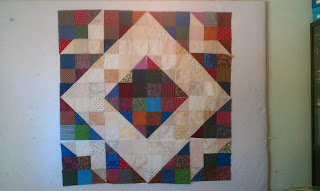Quilting is interesting in that it is both a solitary pursuit and a social endeavor. The social part used to look like quilting bees where all the pioneer ladies gathered round and plied needles while gossiping (and presumably sharing sewing tips). Now that interactive piece is expanded to include blogging, youtube videos, online tutorials, and Facebook.
Yes, Facebook is a quilting tool for me.
Here's one example.
I was making a quilt for a friend, and I was at that dangerous point where I was frustrated with it and losing the love. The risk that it would end up in a ziplock baggie in the back of my closet was high. I had a lot of blocks made up, but none of the arrangements I had tried so far was making me happy. I was doubting the fabric choices (vintage scraps given to me) and feeling like the 5 inch blocks were too big and graceless.
I photographed my various block layout options with my cell phone. A quick photo is a great way to track back to a previous arrangement without having to rethink it all from scratch again.
I still didn't love any of them.
Mulling didn't help.
So I posted on Facebook, and asked my 238 friends for input. Strangely, some of them didn't have anything constructive to say, possibly because I befriend people who are not necessarily quilting enthusiasts.
But several useful things happened:
- There was a consensus of opinion that one of my layouts was more appealing.
- The friend for whom I was making the quilt (as a surprise) commented that she really loved the colors and the design and that she admired my crafty skills and wished she knew how to make quilts. . .
- When I saw the thumbnail photos, I realized that I needed a frame of darker blocks.
Now, as it happens, I didn't personally like the design that everyone else liked (#6) but all those votes for it helped me realize that my friends were all wronge, and that I was right, so I stuck with my original preference, which was #1.
The biggest benefit to the social media input was the fact that my friend commented that she liked what she saw on the design wall. See, I don't love that color palette, and I found myself doubting and second guessing constantly -- hence the high risk for ditching the whole project. But when I had good reason to believe that it was, in fact, just the kind of color scheme and design that she would really like, I had the motivation and energy to finish it up in time for her birthday.
And here's a photo of the completed quilt:























